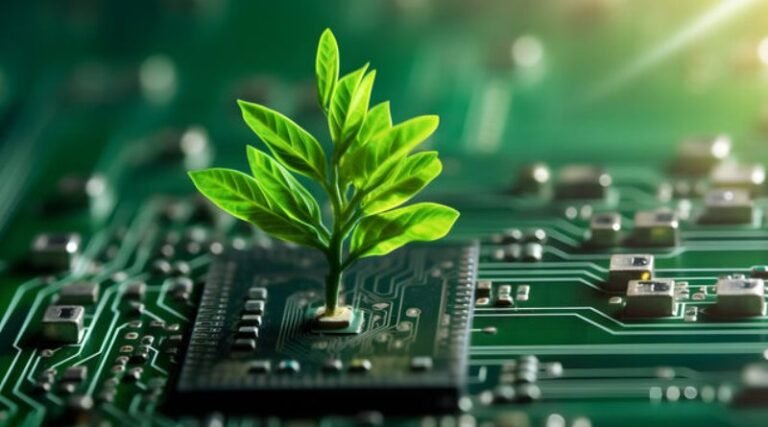Green Technology: How Tech is Addressing Climate Change Challenges
In recent years, the urgency to combat climate change has become increasingly clear, and technology has stepped up to play a pivotal role in addressing this global challenge. Green technology, often referred to as clean or sustainable technology, is at the forefront of this movement, providing innovative solutions to reduce environmental impact and create a more sustainable future.
This article explores the different ways in which technology is being used to tackle climate change, highlighting key innovations that could change the course of our planet’s future.
Renewable Energy: Powering a Cleaner Tomorrow
One of the most significant advancements in green technology is the rapid growth of renewable energy sources. Solar, wind, hydroelectric, and geothermal energy are becoming increasingly efficient and cost-effective, making it easier to reduce dependence on fossil fuels.
Solar power is perhaps the most well-known of these, with solar panels becoming a common sight on rooftops around the world. Advances in photovoltaic technology have increased energy conversion efficiency, while the cost of solar panels has dropped significantly. This means solar power is now accessible to more homes and businesses, helping reduce carbon emissions.
Wind energy has also seen tremendous growth, especially with the development of offshore wind farms. These massive turbines harness strong coastal winds, providing a clean, renewable energy source. By expanding the capacity of wind power, nations are cutting down on their reliance on coal and gas, leading to cleaner air and fewer greenhouse gas emissions.
Electric Vehicles: Revolutionizing Transportation
The transportation sector is one of the largest contributors to global carbon emissions. Traditional gasoline and diesel-powered vehicles emit harmful pollutants into the atmosphere, but the rise of electric vehicles (EVs) is beginning to change that. EVs produce zero emissions, and with the increased production of renewable energy, they are becoming an essential part of reducing transportation’s carbon footprint.
In addition to personal vehicles, the development of electric buses, trucks, and even airplanes is making green transportation more viable across industries. Battery technology is advancing rapidly, leading to longer ranges and shorter charging times, further encouraging the transition to electric.
Energy Efficiency: Smarter Buildings, Smarter Consumption
Green technology is also helping reduce energy consumption by improving the efficiency of buildings and infrastructure. Smart grids and smart meters are revolutionizing the way we manage and distribute electricity, allowing for better monitoring of energy use and reducing wastage.
In commercial and residential buildings, smart thermostats, energy-efficient appliances, and LED lighting are becoming standard. These technologies automatically adjust energy consumption to minimize waste, leading to lower carbon emissions and reduced utility costs.
Carbon Capture and Storage: Mitigating What’s Already There
While reducing emissions is critical, there’s also a growing focus on addressing the carbon dioxide that’s already in the atmosphere. Carbon capture and storage (CCS) technology is designed to do just that by capturing CO2 emissions from industrial processes and storing them underground, preventing them from entering the atmosphere.
Although still in the early stages of development, CCS technology holds enormous potential. Several pilot projects around the world have demonstrated its effectiveness, and as the technology matures, it could play a major role in reversing the damage already done to the environment.
Circular Economy: Reducing Waste and Promoting Sustainability
Another vital aspect of green technology is the promotion of a circular economy—an economic model focused on reusing and recycling materials to minimize waste. This contrasts with the traditional linear economy, where products are created, used, and then discarded.
Tech innovations in recycling, such as advanced materials sorting, biodegradable packaging, and 3D printing from recycled materials, are helping reduce the environmental impact of industries. By extending the life cycle of products and encouraging the reuse of materials, green tech is reducing the burden on natural resources and lowering emissions associated with production and disposal.
The Role of AI and Big Data: Optimizing for Sustainability
Artificial intelligence (AI) and big data are increasingly being leveraged to combat climate change. By analyzing vast amounts of data, AI can identify patterns and suggest more efficient solutions to various environmental challenges.
For example, AI is being used to optimize renewable energy grids, predict weather patterns for better energy planning, and improve agricultural practices to reduce water and fertilizer usage. In the realm of climate science, AI helps researchers model the future impacts of climate change, enabling policymakers to make informed decisions about environmental regulations.
Challenges and the Road Ahead
While green technology offers hope, there are still challenges to overcome. High upfront costs, political hurdles, and the need for global collaboration can slow the adoption of green solutions. However, the benefits of these technologies are undeniable, and as investment grows, costs are expected to decrease, making them more accessible.
Conclusion
Green technology is a powerful force in the fight against climate change. From renewable energy to electric vehicles, carbon capture, and AI-driven solutions, innovation is driving us toward a cleaner, more sustainable future. While challenges remain, the progress we’ve seen so far shows that with the right technologies and policies, we can address the climate crisis and preserve the planet for future generations.
The journey may be long, but the destination—a sustainable, green world—is well worth the effort.

